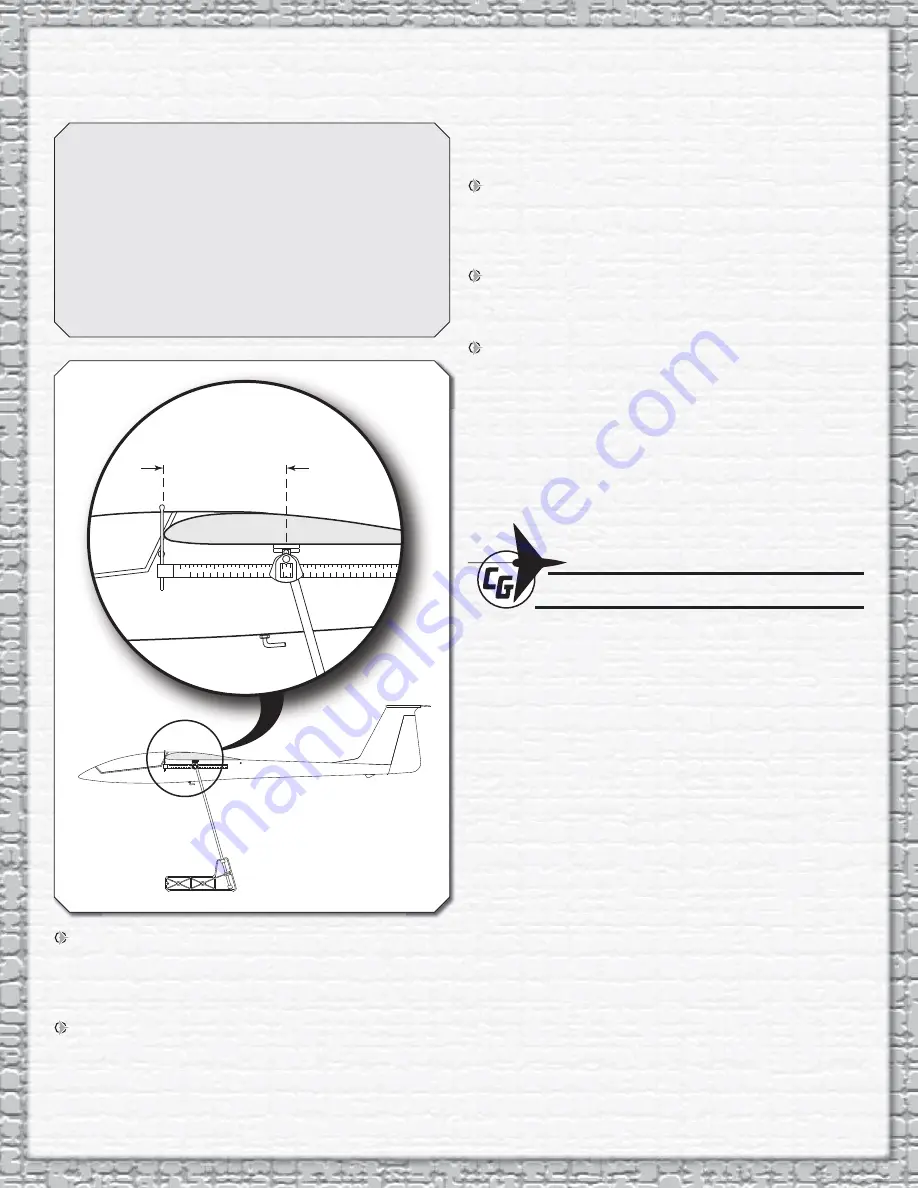
13
edge. Apply narrow (1/16" [2mm]) strips of tape over the lines
so you will be able to feel them when lifting the model with
your fi ngers.
This is where your model should balance for the fi rst
fl ights. Later, you may experiment by shifting the C.G. 1/8"
[3mm] forward or 1/8" [3mm] back to change the fl ying
characteristics. Moving the C.G. forward will improve
the smoothness and stability, but the model will then be
less sensitive (which may be fi ne for less-experienced
pilots). Moving the C.G. aft makes the model more
maneuverable and improves the sailplane’s response to
air currents. In any case, start at the recommended
balance point and do not at any time balance the model
outside the specifi ed range.
3-5/8" [92mm]
2. With the wing attached to the fuselage, and all parts of
the model installed (ready to fl y), place the model right side
up on a Great Planes CG Machine, or lift it at the balance
point you marked.
3. If the tail drops, the model is “tail heavy.” Weight will need
to be added to the nose to get the model to balance. If the
nose drops, the model is “nose heavy.” If needed, the receiver
and receiver battery can be moved aft of the servos. If weight
is required use Great Planes “stick-on” lead (GPMQ4485).
To fi nd out how much weight is required, place incrementally
increasing amounts of weight on the top of the fuselage over
the location where it would be mounted inside until the model
balances. The Sophisticated Lady has a weight compartment
in the nose where lead or BBs can be added. Once the amount
of weight that is required in the nose is determined, the BBs
can be glued in using white glue.
4. IMPORTANT: If you found it necessary to add any weight,
recheck the C.G. after the weight has been installed.
BALANCE THE MODEL LATERALLY
1. With the wing level, have an assistant help you lift the
model by the nose and the bottom of the fuse under the TE
of the fi n. Do this several times.
2. If one wing always drops when you lift the model, it means
that side is heavy. Balance the airplane by adding weight
to the other wing tip. An airplane that has been laterally
balanced will track better.
CHECKING FOR WARPS
This is a very important step and should be done occasionally
throughout the fl ying season. A sailplane’s wing is most effi cient
when it is not twisted or warped at all. “Washout” (the wing’s
trailing edges are twisted up at the tips) helps make a poor
wing design fl y better by adding some stability (preventing
stalls) at slow speeds but it cuts down on the wing’s effi ciency
at normal speeds. The Sophisticated Lady ARF’s wing is
designed to fl y well at slow speeds without any washout, and
therefore we recommend you check to make sure the wings
are “fl at” using the following procedure:
Set the wing so an inner panel is resting on a fl at surface. Any
warp (twist) will show up by causing a corner of the panel to
rise off the work surface.
To remove the warp, gently twist the wing in the opposite
direction while a helper glides an iron or heat gun over the
covering on both the top and the bottom of the panel to re-
shrink the covering. Hold the twist until the covering cools
and then recheck for warps. It may take several tries to get a
warp out, but it is worth it as you will end up with a sailplane
that fl ies straight and true and responds to air currents like a
high performance sailplane should.
Follow the same procedure to check all four wing panels and
then go back and double check them. Sometimes you put a
warp in one wing panel while trying to fi x another. You should
also look at the tail surfaces as they too can warp.







































